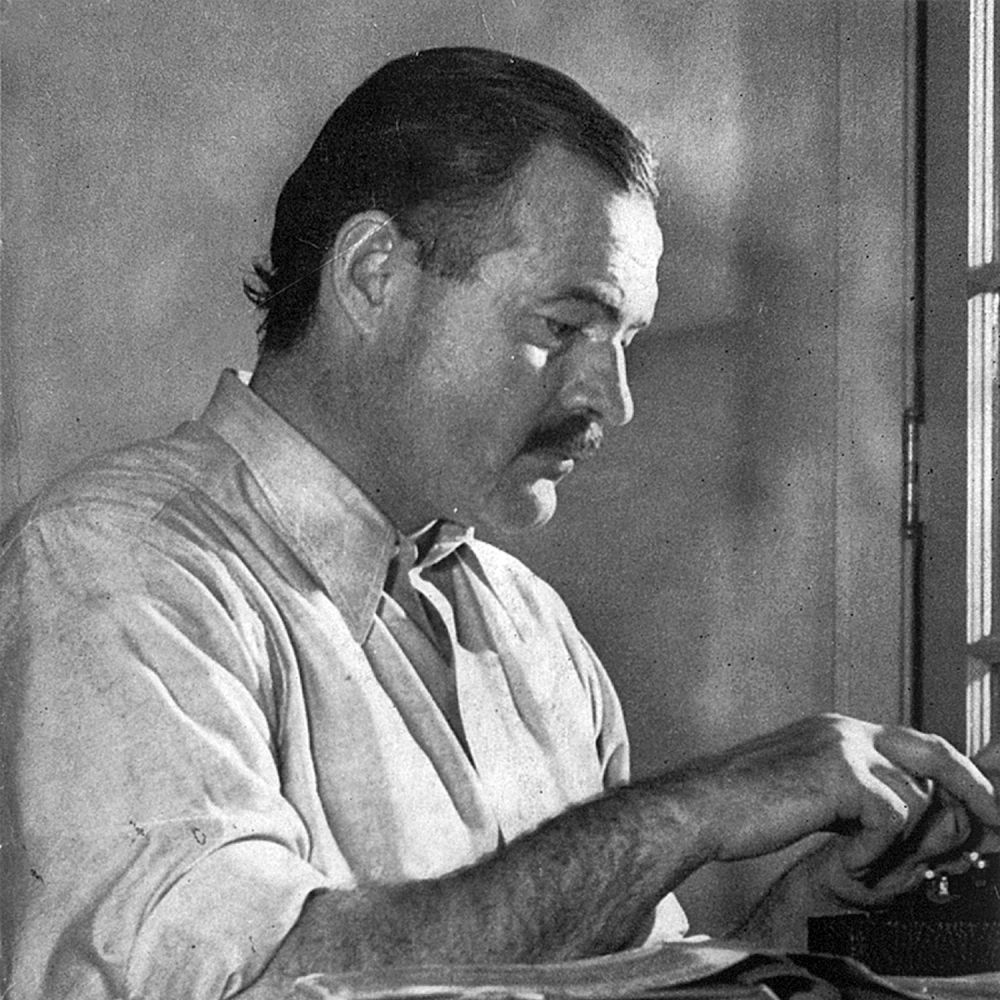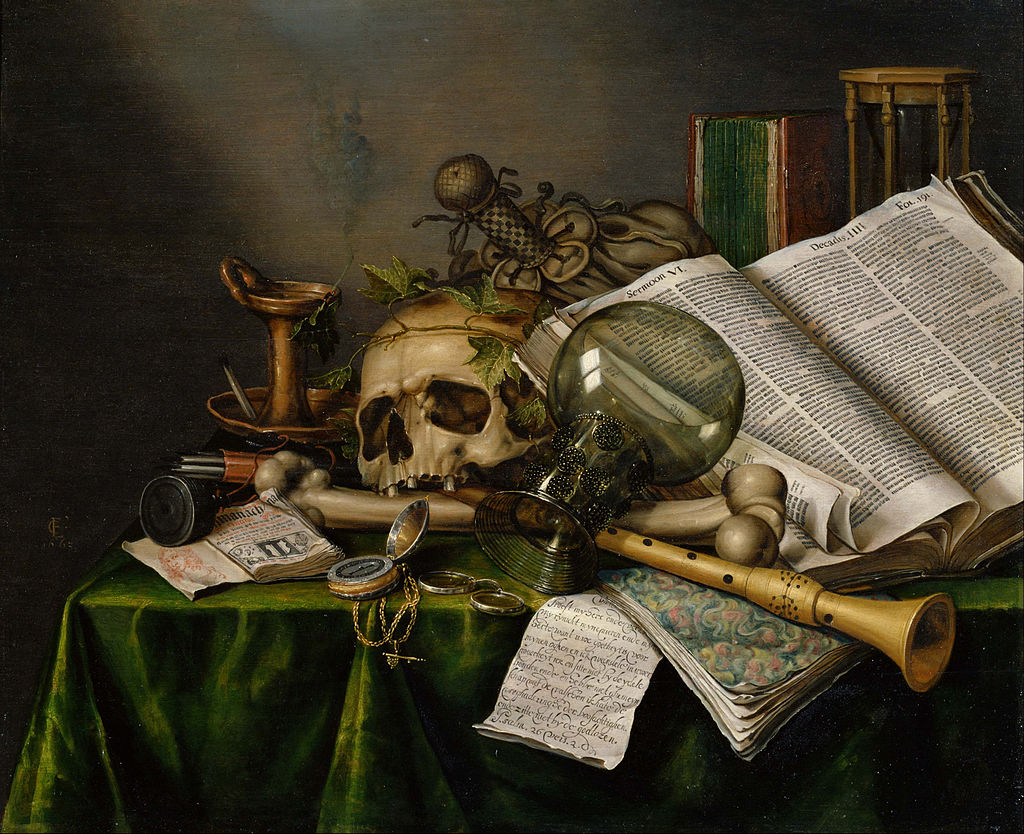Issue 18, Spring 1958
 Ernest Hemingway, ca. 1939. Photograph by Lloyd Arnold
Ernest Hemingway, ca. 1939. Photograph by Lloyd Arnold
HEMINGWAY
You go to the races?
INTERVIEWER
Yes, occasionally.
HEMINGWAY
Then you read the Racing Form ... There you have the true art of fiction.
—Conversation in a Madrid cafe, May, 1954
Ernest Hemingway writes in the bedroom of his house in the Havana suburb of San Francisco de Paula. He has a special workroom prepared for him in a square tower at the southwest corner of the house, but prefers to work in his bedroom, climbing to the tower room only when “characters” drive him up there.
The bedroom is on the ground floor and connects with the main room of the house. The door between the two is kept ajar by a heavy volume listing and describing “The World’s Aircraft Engines.” The bedroom is large, sunny, the windows facing east and south letting in the day’s light on white walls and a yellow-tinged tile floor.
The room is divided into two alcoves by a pair of chest-high bookcases that stand out into the room at right angles from opposite walls. A large and low double-bed dominates one section, over-sized slippers and loafers neatly arranged at the foot, the two bedside tables at the head piled seven-high with books. In the other alcove stands a massive flat-top desk with two chairs at either side, its surface an ordered clutter of papers and mementos. Beyond it, at the far end of the room, is an armoire with a leopard skin draped across the top. The other walls are lined with white-painted bookcases from which books overflow to the floor, and are piled on top amongst old newspapers, bullfight journals, and stacks of letters bound together by rubber bands.
It is on the top of one of these cluttered bookcases—the one against the wall by the east window and three feet or so from his bed—that Hemingway has his “work-desk”—a square foot of cramped area hemmed in by books on one side and on the other by a newspaper-covered heap of papers, manuscripts, and pamphlets. There is just enough space left on top of the bookcase for a typewriter, surmounted by a wooden reading-board, five or six pencils, and a chunk of copper ore to weight down papers when the wind blows in from the east window.
A working habit he has had from the beginning, Hemingway stands when he writes. He stands in a pair of his oversized loafers on the worn skin of a lesser kudu—the typewriter and the reading-board chest-high opposite him.
When Hemingway starts on a project he always begins with a pencil, using the reading-board to write on onionskin typewriter paper. He keeps a sheaf of the blank paper on a clipboard to the left of the typewriter, extracting the paper a sheet at a time from under a metal clip that reads “These Must Be Paid”. He places the paper slantwise on the reading-board, leans against the board with his left arm, steadying the paper with his hand, and fills the paper with handwriting which through the years has become larger, more boyish, with a paucity of punctuation, very few capitals, and often the period marked with an x. The page completed, he clips it facedown on another clipboard which he places off to the right of the typewriter.
Hemingway shifts to the typewriter, lifting off the reading-board, only when the writing is going fast and well, or when the writing is, for him at least, simple: dialogue, for instance.
He keeps track of his daily progress—“so as not to kid myself”—on a large chart made out of the side of a cardboard packing case and set up against the wall under the nose of a mounted gazelle head. The numbers on the chart showing the daily output of words differ from 450, 575, 462, 1250, to 512, the higher figures on days Hemingway puts in extra work so he won’t feel guilty spending the following day fishing on the Gulf Stream.
A man of habit, Hemingway does not use the perfectly suitable desk in the other alcove. Though it allows more space for writing, it too has its miscellany: stacks of letters, a stuffed toy lion of the type sold in Broadway nighteries, a small burlap bag full of carnivore teeth, shotgun shells, a shoehorn; wood carvings of lion, rhino, two zebras, and a wart-hog—these last set in a neat row across the surface of the desk—and, of course, books. You remember books of the room, piled on the desk, beside tables, jamming the shelves in indiscriminate order—novels, histories, collections of poetry, drama, essays. A look at their titles shows their variety. On the shelf opposite Hemingway’s knee as he stands up to his “work-desk” are Virginia Woolf’s The Common Reader, Ben Ames Williams’ House Divided, The Partisan Reader, Charles A. Beard’s The Republic, Tarle’s Napoleon’s Invasion of Russia, How Young You Look by one Peggy Wood, Alden Brooks’s Shakespeare and the Dyer’s Hand, Baldwin’s African Hunting, T. S. Eliot’s Collected Poems, and two books on General Custer’s fall at the battle of the Little Big Horn.
The room, however, for all the disorder sensed at first sight, indicates on inspection an owner who is basically neat but cannot bear to throw anything away—especially if sentimental value is attached. One bookcase top has an odd assortment of mementos: a giraffe made of wood beads, a little cast-iron turtle, tiny models of a locomotive, two jeeps and a Venetian gondola, a toy bear with a key in its back, a monkey carrying a pair of cymbals, a miniature guitar, and a little tin model of a U.S. Navy biplane (one wheel missing) resting awry on a circular straw placemat—the quality of the collection that of the odds-and-ends which turn up in a shoebox at the back of a small boy’s closet. It is evident, though, that these tokens have their value, just as three buffalo horns Hemingway keeps in his bedroom have a value dependent not on size but because during the acquiring of them things went badly in the bush which ultimately turned out well. “It cheers me up to look at them,” Hemingway says.
Hemingway may admit superstitions of this sort, but he prefers not to talk about them, feeling that whatever value they may have can be talked away. He has much the same attitude about writing. Many times during the making of this interview he stressed that the craft of writing should not be tampered with by an excess of scrutiny—“that though there is one part of writing that is solid and you do it no harm by talking about it, the other is fragile, and if you talk about it, the structure cracks and you have nothing.”
As a result, though a wonderful raconteur, a man of rich humor, and possessed of an amazing fund of knowledge on subjects which interest him, Hemingway finds it difficult to talk about writing—not because he has few ideas on the subject, but rather because he feels so strongly that such ideas should remain unexpressed, that to be asked questions on them “spooks” him (to use one of his favorite expressions) to the point where he is almost inarticulate. Many of the replies in this interview he preferred to work out on his reading-board. The occasional waspish tone of the answers is also part of this strong feeling that writing is a private, lonely occupation with no need for witnesses until the final work is done.
This dedication to his art may suggest a personality at odds with the rambunctious, carefree, world-wheeling Hemingway-at-play of popular conception. The point is, though, that Hemingway, while obviously enjoying life, brings an equivalent dedication to everything he does—an outlook that is essentially serious, with a horror of the inaccurate, the fraudulent, the deceptive, the half-baked.
Nowhere is the dedication he gives his art more evident than in the yellow-tiled bedroom—where early in the morning Hemingway gets up to stand in absolute concentration in front of his reading-board, moving only to shift weight from one foot to another, perspiring heavily when the work is going well, excited as a boy, fretful, miserable when the artistic touch momentarily vanishes—slave of a self-imposed discipline which lasts until about noon when he takes a knotted walking stick and leaves the house for the swimming pool where he takes his daily half-mile swim.
INTERVIEWER
Are these hours during the actual process of writing pleasurable?
ERNEST HEMINGWAY
Very.
INTERVIEWER
Could you say something of this process? When do you work? Do you keep to a strict schedule?
HEMINGWAY
When I am working on a book or a story I write every morning as soon after first light as possible. There is no one to disturb you and it is cool or cold and you come to your work and warm as you write. You read what you have written and, as you always stop when you know what is going to happen next, you go on from there. You write until you come to a place where you still have your juice and know what will happen next and you stop and try to live through until the next day when you hit it again. You have started at six in the morning, say, and may go on until noon or be through before that. When you stop you are as empty, and at the same time never empty but filling, as when you have made love to someone you love. Nothing can hurt you, nothing can happen, nothing means anything until the next day when you do it again. It is the wait until the next day that is hard to get through.
INTERVIEWER
Can you dismiss from your mind whatever project you’re on when you’re away from the typewriter?
HEMINGWAY
Of course. But it takes discipline to do it and this discipline is acquired. It has to be.
INTERVIEWER
Do you do any rewriting as you read up to the place you left off the day before? Or does that come later, when the whole is finished?
HEMINGWAY
I always rewrite each day up to the point where I stopped. When it is all finished, naturally you go over it. You get another chance to correct and rewrite when someone else types it, and you see it clean in type. The last chance is in the proofs. You’re grateful for these different chances.
INTERVIEWER
How much rewriting do you do?
HEMINGWAY
It depends. I rewrote the ending to Farewell to Arms, the last page of it, thirty-nine times before I was satisfied.
INTERVIEWER
Was there some technical problem there? What was it that had stumped you?
HEMINGWAY
Getting the words right.




